Learn to Specify Terrazzo Floors
Get an introduction to terrazzo specification. The article focuses on the basics covering topics on epoxy vs cement systems, cost and planning, and design options to consider.
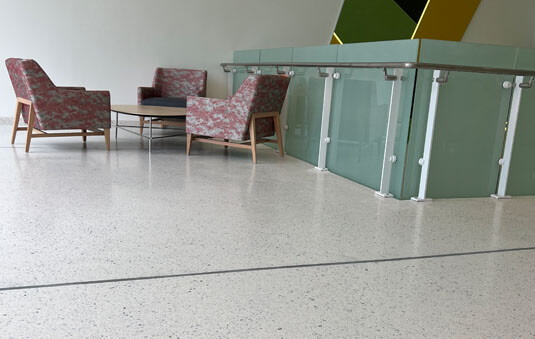
Terrazzo is a timeless material often specified in schools, airports, hospitals, and other commercial settings for its durability, low maintenance, and aesthetic appeal.
Terrazzo is simply a composite material consisting of aggregates mixed with either a cement or epoxy matrix. While used mainly as a flooring system, it can be applied as countertops, stair treads, and other custom products.
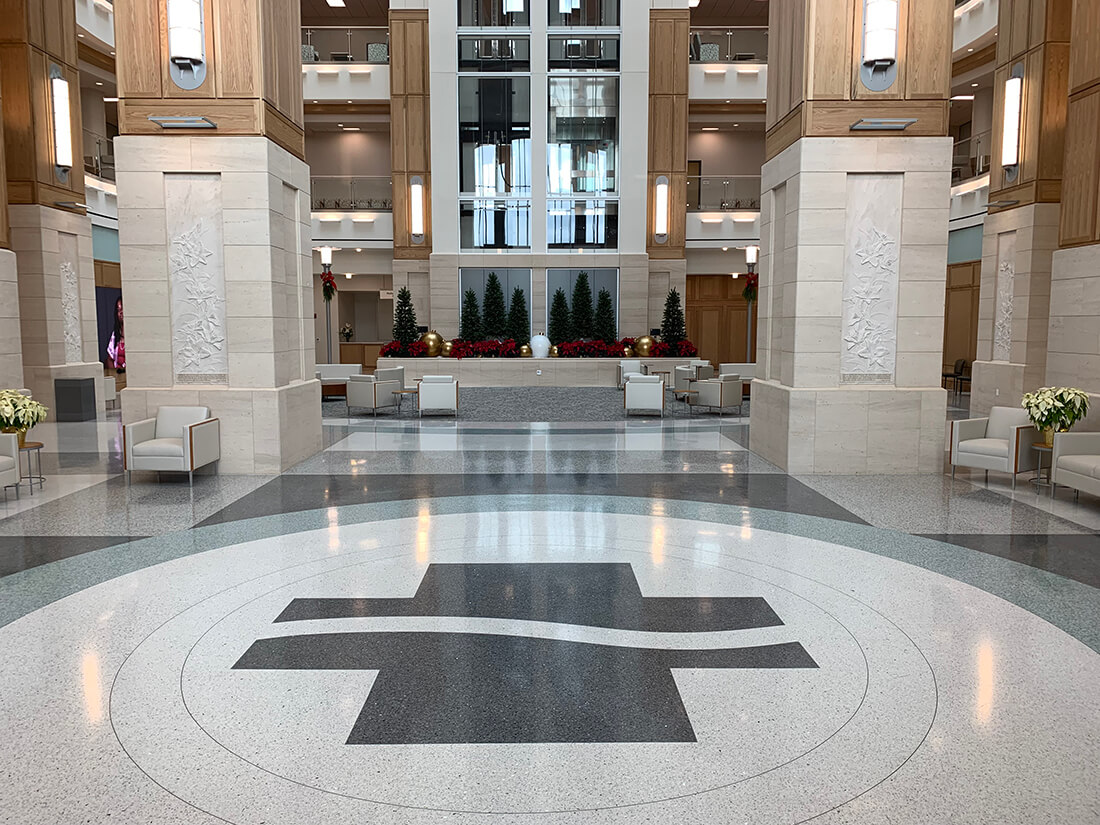
Hospital using TERRAZZCO EZPour Epoxy 158 epoxy terrazzo system
Terrazzo Origins
To best understand terrazzo, it’s best to discuss its foundations. Terrazzo originated during the 15th century in Italy, where Venetian marble workers reused marble pieces to form inexpensive flooring for their terraces. Today you will find many different types of terrazzo systems available to install. It’s truly a one-of-a-kind flooring system with endless possibilities. Classic terrazzo uses marble fragments, referred to as aggregate or marble chips in the terrazzo industry, and a cementitious binding agent, known as the matrix. Many older buildings prior to the 1970s had cement terrazzo floors, which are resilient to this day. It can be cast in place or manufactured in tile form, which could be installed in either an interior or exterior space.
Introduction of Epoxies
The introduction to epoxies in the 1970s led to groundbreaking advancements in terrazzo. Its popularity rose over the decades and today the majority of terrazzo installations use an epoxy matrix. What are the advantages of epoxy terrazzo? For one, it is lighter and thinner than cement terrazzo floors. It’s also quicker to install an epoxy terrazzo floor. Like cement terrazzo, marble chips are standard in epoxy terrazzo floors but options including recycled glass, mirrors and shells offer designers greater flexibility in their floor designs. Epoxy terrazzo is regarded as one of the most cost-effective flooring systems available on the market today. It’s widely used in high-traffic areas of schools, airports, and offices.
Over the last decade, terrazzo has experienced a renaissance in the architectural and design community. With the importance of using sustainable materials in green construction, epoxy terrazzo gets looked at for its components including recycled materials and zero VOC resins.
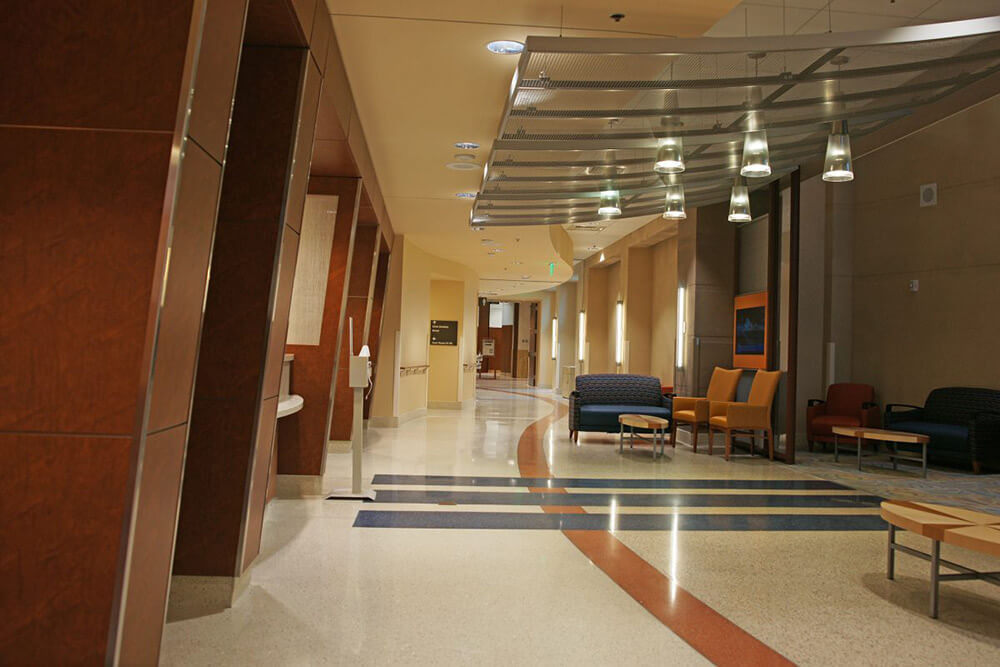
This feature provides insights from top representatives in the terrazzo industry on what architects need to consider for their terrazzo specification.
Epoxy or Cement Terrazzo?
Key Points:
- There are multiple terrazzo systems available
- Epoxy terrazzo is considered the standard today
- Epoxy terrazzo offers greater design flexibility
- If you are looking to do terrazzo outdoors, choose cement terrazzo
Epoxy Terrazzo: Most Used Terrazzo System Today
When selecting terrazzo floors for a project, it is important to decide whether to specify a traditional cement matrix or go with the new standard, epoxy matrix. Today, about 90 percent of terrazzo is epoxy-based. Why is epoxy terrazzo a popular choice among designers? For one, design flexibility is a major draw for epoxy terrazzo. Epoxy can be created in any color the designer wants. Other reasons include the speed of install, support of crack suppression membranes, and the lightweight of epoxy terrazzo.
When to Consider Cement Terrazzo?
If epoxy terrazzo is used widely across the market today, when should cement terrazzo be considered? Representatives will point out to use of cement terrazzo if terrazzo is considered for outdoor use, or for restoration projects where there is not an active vapor barrier beneath the slab. Moisture is a drawback for epoxy terrazzo. In situations where there is not enough vapor protection, it can cause issues with the terrazzo bonding to a concrete slab. Prior to installing epoxy terrazzo for indoor applications, it’s essential that the slab is acceptable. Terrazzo manufacturers offer a solution in moisture mitigation systems that can be considered during epoxy terrazzo installations.
Terrazzo installations are performed by skilled craftsmen. Contractors associated with the National Terrazzo and Mosaic Association meet standards to install quality work. While the terrazzo industry has shifted to epoxy-based installations, it is important to find a skilled contractor that can perform cement terrazzo installations.
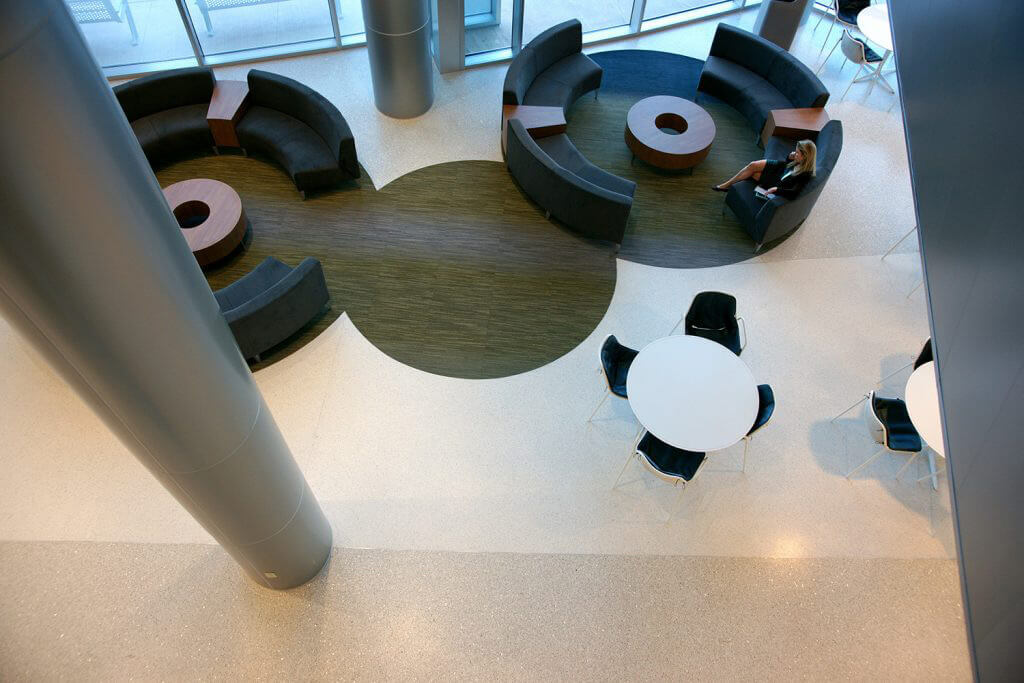
UF Health Clinic using TERRAZZCO EZPour Epoxy 158 epoxy terrazzo system
Precast or Poured-in-Place?
Key Points:
- Poured-in-place is installed by skilled craftsmen, typically an installation company associated with the NTMA
- Poured-in-place is easier to maintain
- Poured-in-place offers greater design flexibility.
- Poured-in-place can cure overnight and be walked on the next day.
Poured-in-Place Terrazzo
Poured-in-place terrazzo is one of the most durable flooring systems available today. Once installed, it can last the lifetime of any commercial building. This rewards building owners with low lifecycle costs.
Poured-in-place terrazzo creates a seamless floor system, where the terrazzo is monolithically bonded to the substrate. As terrazzo is bonded to the slab, the concrete substrate will break before the bond between the slab and the terrazzo does. It’s important to know that epoxy terrazzo is less susceptible to crack than cement terrazzo. Epoxy terrazzo systems have minimal need for repairs and replacements in the floor’s lifecycle.
Terrazzo Tile
Tile is an option that designers consider as well. Whereas poured-in-place systems are absent of grout joints, a tile floor comes with grout joints. Therefore, it’s much easier to main a poured-in-place terrazzo system than a terrazzo tile product.
As mentioned, terrazzo requires a skilled team to perform the installation. For poured-in-place terrazzo systems, machinery is used to grind and polish the floor once the terrazzo has been cured. On the other hand, terrazzo tile is manufactured off-site. Tile is a suitable option for smaller projects based on budget and ease of installation. There are multiple terrazzo companies that can produce terrazzo tiles. Precast terrazzo tiles are applied similarly to ceramic and stone tiles.
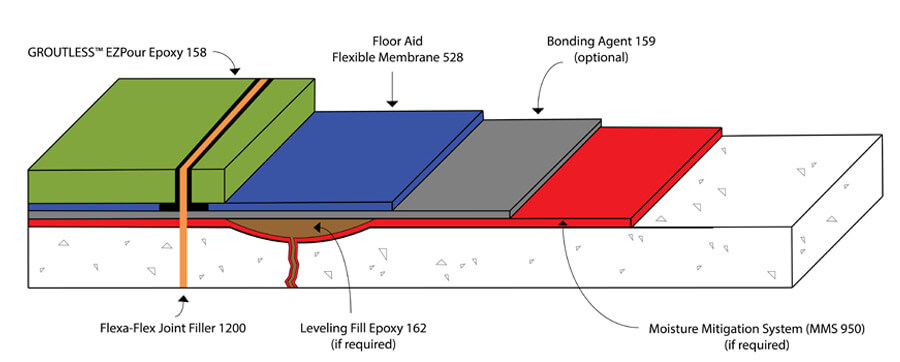
Epoxy Terrazzo System Section Assembly Diagram
Poured-in-place epoxy terrazzo is 3/8″ thick. They are often poured over a concrete base, but can also be applied to underlying surfaces such as plywood, or even existing terrazzo.
Epoxy terrazzo tile is typically 3/8″ thick plus setting material. Cement terrazzo range from 1/2″ to 1 inch in thickness plus setting material.
Venetian Terrazzo
Key Points:
- There are different styles of terrazzo floors depending on the aggregate size.
- Venetian and Palladiana style floors are specialty types but require more planning and costs.
- Keep in mind that epoxy terrazzo is 3/8″ in thickness. It’s possible to include larger aggregates in a 3/8″ epoxy terrazzo floor as long as the aggregate is flat.
One recent trend in the terrazzo industry is the use of larger aggregates in the overall design.
Venetian Terrazzo
Venetian terrazzo uses oversized aggregates (sizes 3 through 8) to create greater contrast in terrazzo, drawing more attention to the aggregate itself. They are a popular style choice among terrazzo floors and countertops.
Rule of thumb: The larger the aggregate, the more expensive the terrazzo design will be.
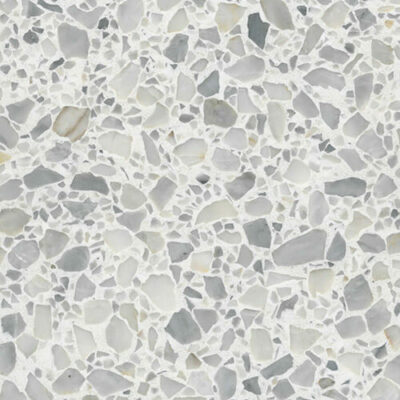
Larger White Aggregate
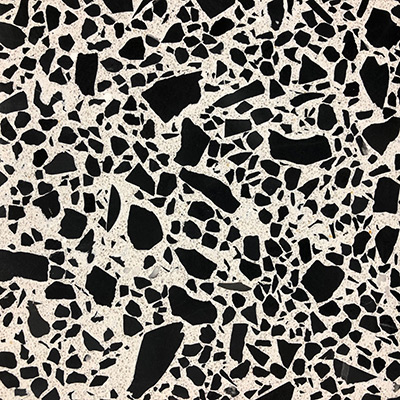
Larger Black Aggregate
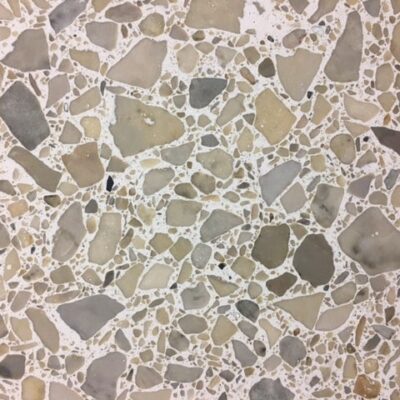
Oversized Aggregate
Aggregate Size
Key Points:
- Aggregates are graded from size 0 to size 8. Standard sizes (0 to 2) are appropriate for epoxy terrazzo floors.
- Venetian chips (size 3 to 8) typically increase the thickness of the terrazzo floor and is typically more expensive.
- Aggregates are processed through crushers. It takes more effort to crush aggregates to finer sizes; therefore a bag of size 2 marble chip costs less to produce than a bag of size 0.
Terrazzo aggregate is graded according to its size regardless of the material. Typical terrazzo uses 0 to 2 aggregate sizes, which range from 1/16 to ⅜ of an inch in diameter. Aggregates can range as small as size 00 to as large as size 8.
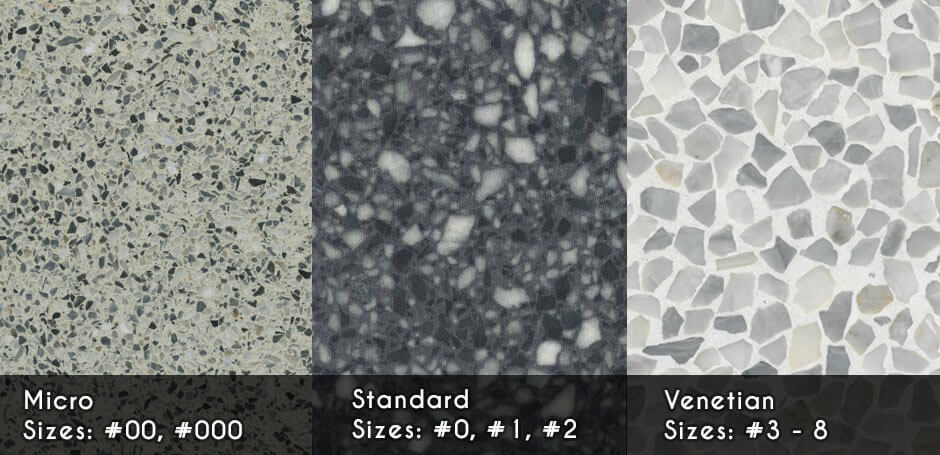
The size of the aggregate is essential to knowing your project costs. When considering epoxy terrazzo floors, its best to use standard size aggregates. Selecting larger aggregates will dictate the thickness of the terrazzo floor. While epoxy terrazzo offers endless possibilities, there are some limitations. It’s best to speak with a terrazzo representative for input on what may work and what might not. Generally smaller aggregates mean a less expensive floor. Most institutions today stick with standard aggregates. There are unlimited outcomes with the amount of marble, glass, and shell chips available. It’s about finding the right combination for your project’s need.
Aggregate Material
Key Points:
- There are many aggregate choices to consider for epoxy terrazzo including marble, granite, glass, shells, plastics and metal chips.
- Recycled mirror and glass chips can contribute to LEED points.
- A 50-pound bag of marble chips will typically cost less than a 50-pound bag of glass or shell chips. Ask your supplier for more details.
A terrazzo floor consists of at least 70% aggregates. Marble chips are common and available in different colors. With epoxy terrazzo, there are other choices to consider, some of which can be specified and contribute to LEED points. Aggregates like recycled glass, mirror, porcelain, and concrete can be considered. LEED points are awarded for use of aggregates sourced within 500 miles of the project site. There are other options to consider including shells, pebbles, and metal shavings, which can offer unique variations to a terrazzo’s design.

Mother of Pearl aggregate – aggregate + terrazzo design (white epoxy)
Dividers
Key Points:
- Divider strips function to control cracking in terrazzo floors and to form the design of the floor.
- There are divider strip options to consider including aluminum, zinc, brass, and plastic divider strips.
- A waterjet can cut pieces of metal to form artwork for a terrazzo floor.
Divider strips don’t get talked about as much as matrix colors and aggregates, but they are important when planning a poured-in-place terrazzo floor. Divider strips provide both form and function, to control cracking but also to form the layout of the design.
There is quite a bit of difference when using divider strips in a cement terrazzo installation versus an epoxy terrazzo installation. Cement terrazzo can only span 3 to 5 feet in distance. Epoxy terrazzo covers larger distances at 20 to 30 feet. Cement terrazzo installations are more limited in design, generally divided into grids. With epoxy terrazzo, a designer can form any pattern they like. Divider strips are often bent on site to form the most decorative designs in flooring.
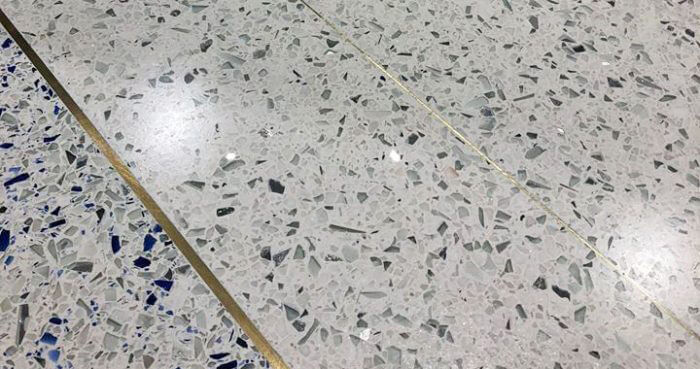
Divider strips are available in different metals – aluminum, zinc or brass. Plastic divider strips are also used to blend in with the terrazzo floor; however, they are not as common as aluminum or zinc.
Wherever there are joints beneath the concrete, a divider strip must be placed. A terrazzo contractor can assist you in determining where the placement of divider strips for your project.
Cost and Planning
Key Points:
- The upfront costs of epoxy terrazzo appear expensive but yield low lifecycle costs due to its durability and low maintenance.
- A terrazzo contractor or supplier can greatly discuss the design process for terrazzo to help you understand your costs.
To get the most out of your terrazzo project, it is best to talk with a terrazzo contractor or supplier early on. Knowing the costs of materials and installation can prevent terrazzo from getting value-engineered out. Because poured-in-place terrazzo is installed and finished by specialty contractors, price estimates often include the cost of materials and installation. Stone or ceramic tile is generally priced at material cost so it can appear significantly cheaper.
Terrazzo floors typically require a bit more planning than other materials. By speaking with a representative, you can understand more about the design process, the costs, and expected lead times. Knowing this information beforehand can eliminate surprises later on. Representatives can assist in increasing your product knowledge and suggest recommendations along the way. They can review terrazzo specifications for your projects.
Terrazzo floors are designed to last a lifetime. The more knowledge designers acquire about terrazzo, the better they can apply it a building space. It’s a beautiful blend of technology, performance, and design.
About Concord Terrazzo Company
If you are looking to specify epoxy terrazzo for your building projects, Concord Terrazzo Company is the place to go to find materials. As a single-source company, Concord Terrazzo Company is the only terrazzo supplier that manufactures its own epoxy, crushes and processes aggregates, and produces precast terrazzo finishes. Talk about epoxy terrazzo with one of our representatives at info@terrazzco.com. We’ll review terrazzo specifications with you!
Download TERRAZZCO 3-Part Specification for Epoxy Terrazzo Floors:
Thin-Set Epoxy Terrazzo Specification #096623 – TERRAZZCO (PDF)
Thin-Set Epoxy Terrazzo Specification #096623 – TERRAZZCO (Microsoft Word)
TERRAZZO INFORMATION
Dive deeper into learning about terrazzo with helpful guides related to the features, design and applications of the building material.
ARCHITECTURAL BINDER
Download our Architectural Binder for more information on terrazzo flooring and TERRAZZCO Brand Products.
PRODUCT DATA
Visit our technical resource page to review all product data on TERRAZZCO epoxy resin, precast terrazzo and aggregate products.



